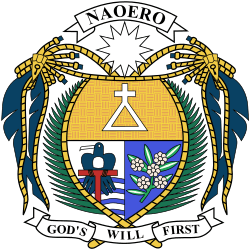Nauruan parliamentary election, 1966
 |
| This article is part of a series on the politics and government of Nauru |
Elections for the Legislative Council were held in Nauru for the first time on 25 January 1966.[1]
Background
Nauru had been under Australian administration since World War II. In 1962 the United Nations General Assembly voted by 80 –0 that the island should be granted independence.[2] The United Nations Trusteeship Council subsequently requested that the Australian government set up a Legislative Council.[3] On 9 December 1965 the Australian Parliament debated a bill to establish a Council, which was passed as the Nauru Act 1965.
Electoral system
The electoral system remained the same as for the Local Government Council; the fourteen districts of Nauru were grouped into eight constituencies. Seven constituencies elected one member, whilst one elected two.[4] A total of 24 candidates stood for the nine seats.[1]
Results
Hammer DeRoburt (Boe constituency) and Roy Degoregore (Anetan and Ewa) were both elected unopposed.[5] All elected candidates had previously been members of the Local Government Council at some point.[5]
| Constituency | Elected members |
|---|---|
| Aiwo | Samuel Edwin Tsitsi |
| Anabar, Ijuw and Anibare | Agoko James Doguape |
| Anetan and Ewa | Roy Degoregore |
| Boe | Hammer DeRoburt |
| Buada | Austin Bernicke |
| Denigomodu, Nibok, Uaboe and Baiti | I. Victor Eoaeo, Robidok Buraro Bagewa Detudamo |
| Meneng | James Ategan Bop |
| Yaren | Joseph Detsimea Audoa |
| Source: Viviani | |
Aftermath
The new Legislative Council opened on 31 January 1966, which marked the twentieth anniversary of the return to Nauru of survivors of the World War II deportation of islanders during the Japanese occupation.[5] Hammer DeRoburt was re-elected as Head Chief by the Council after the elections.[5]